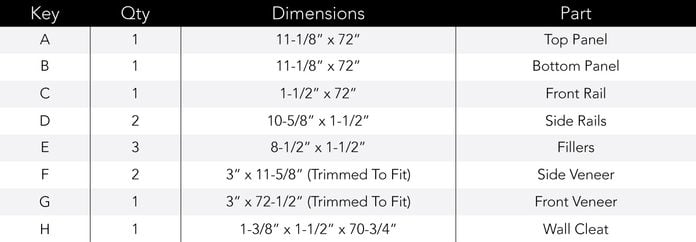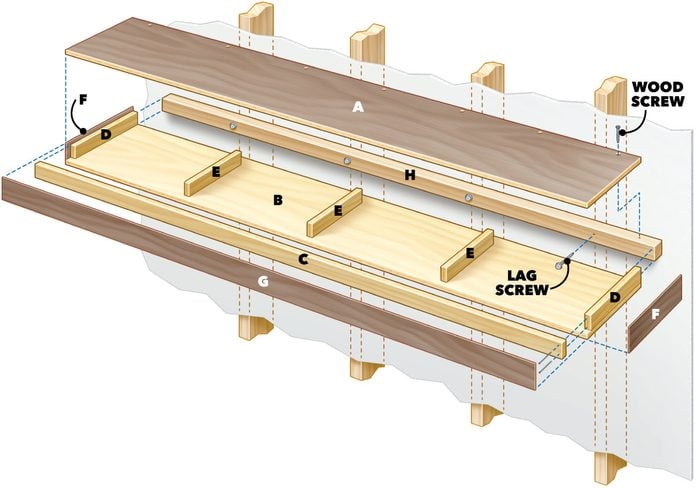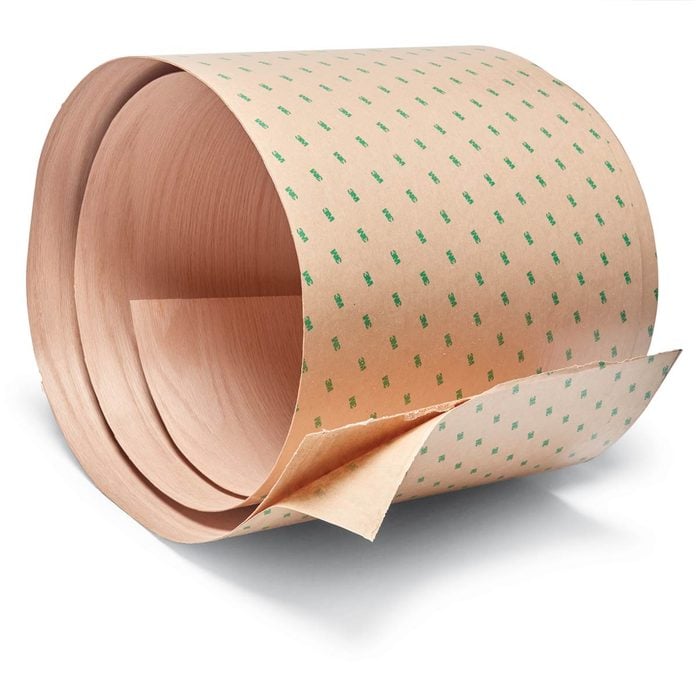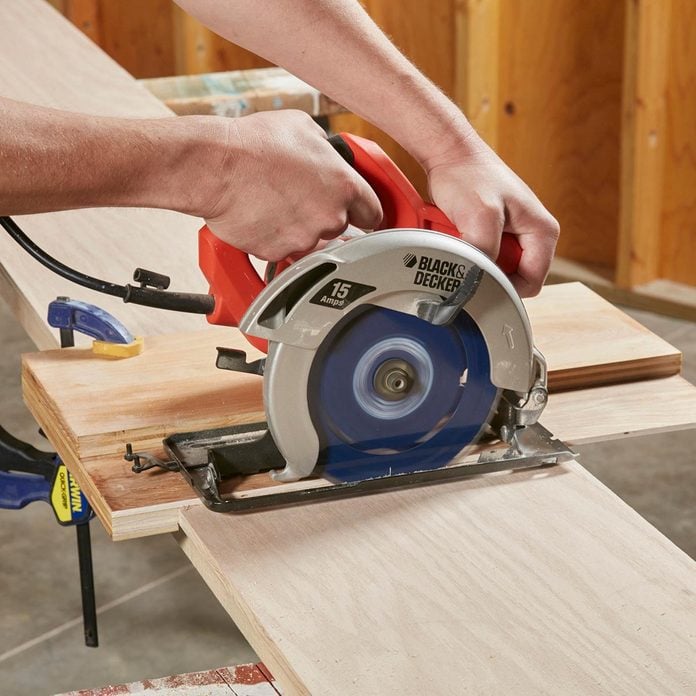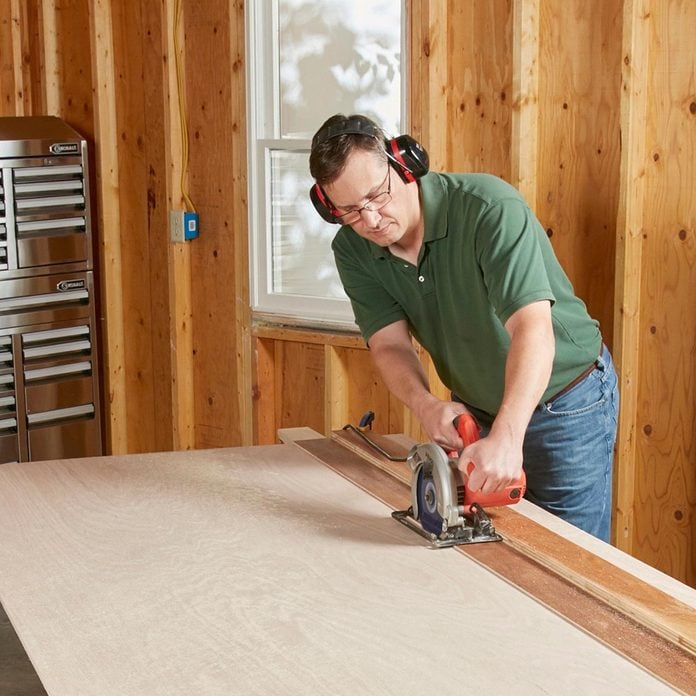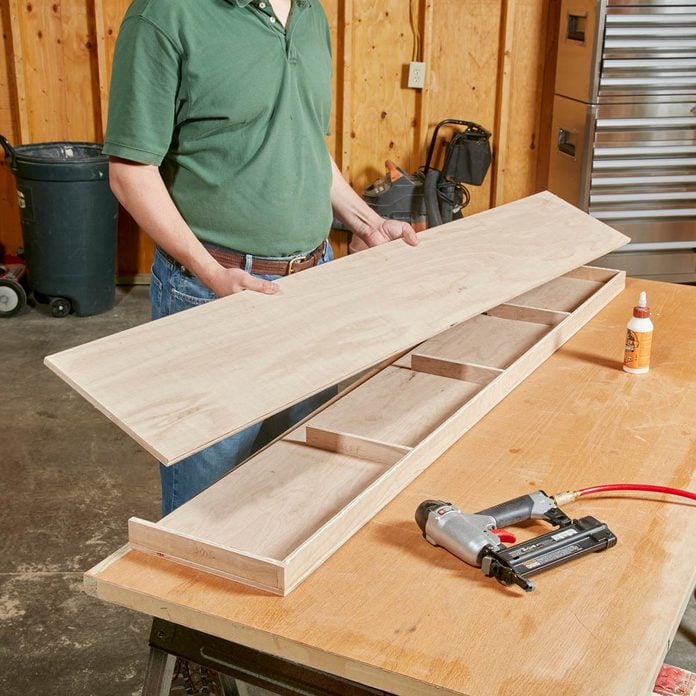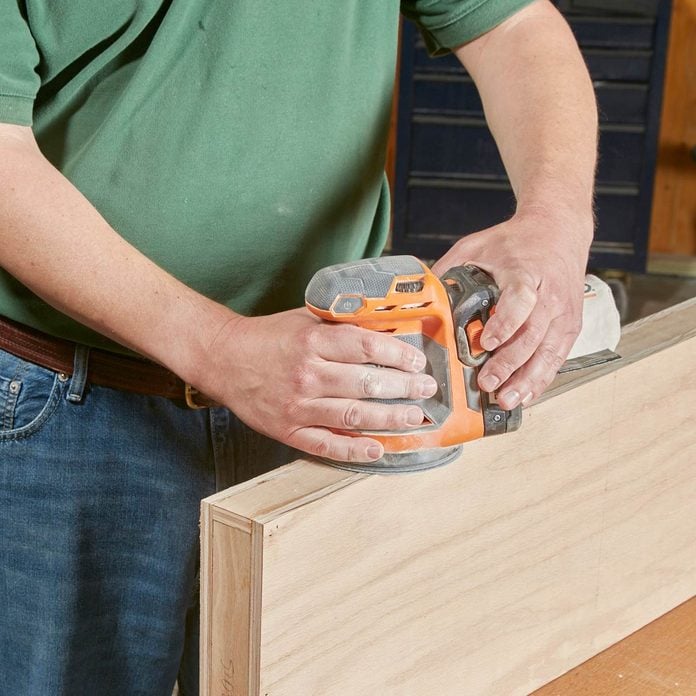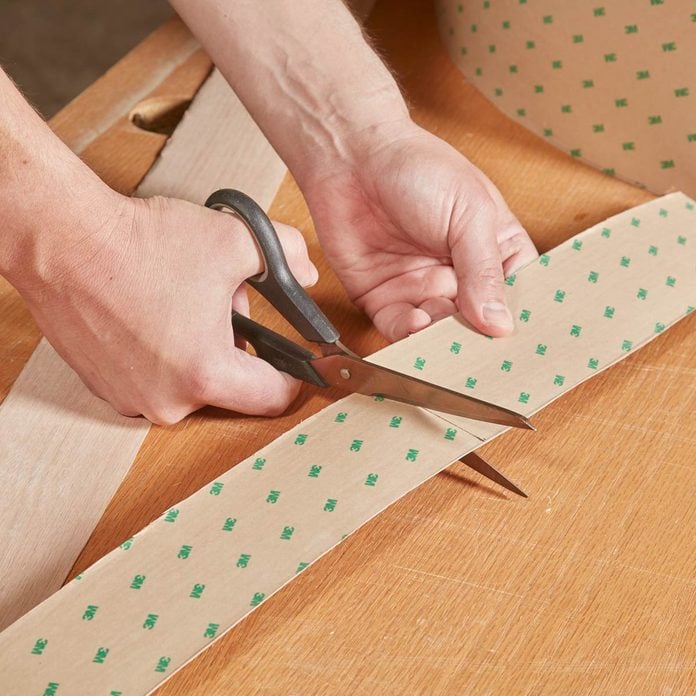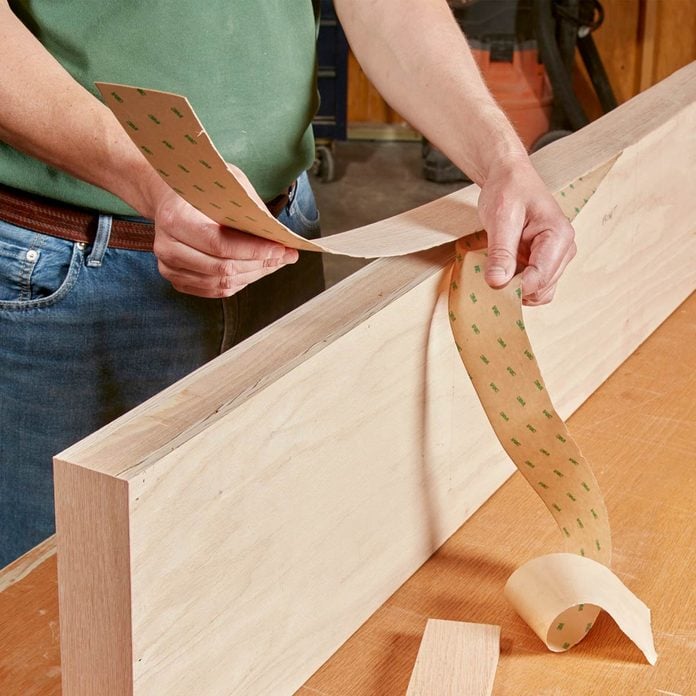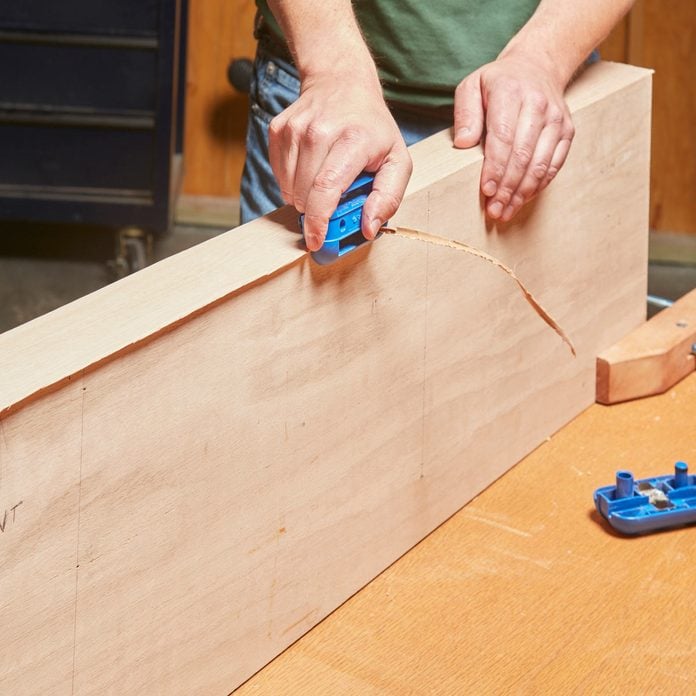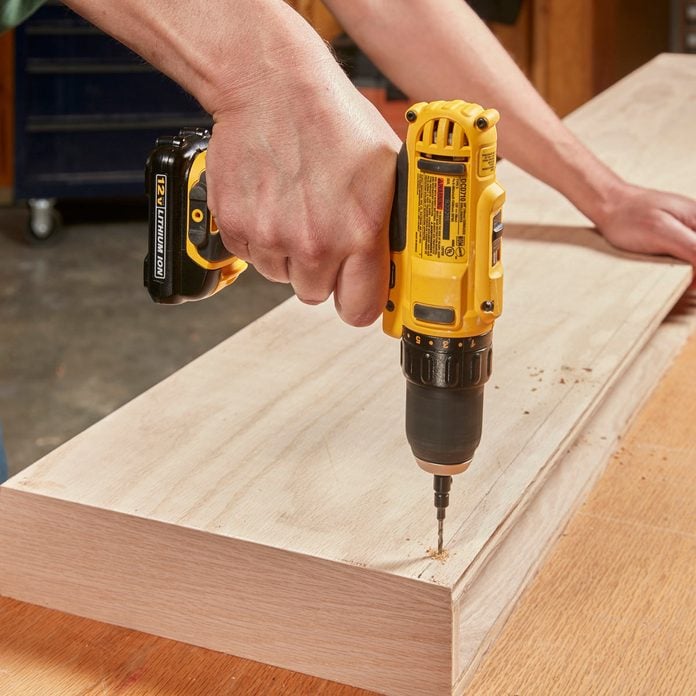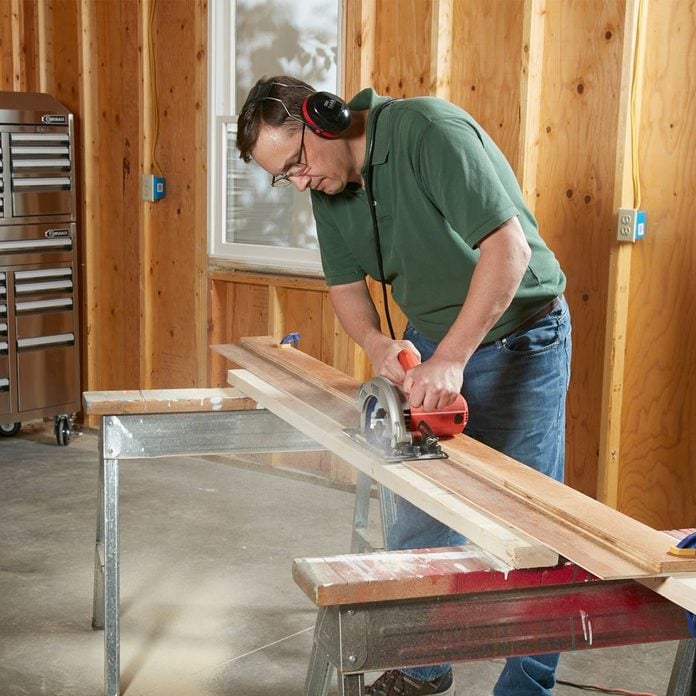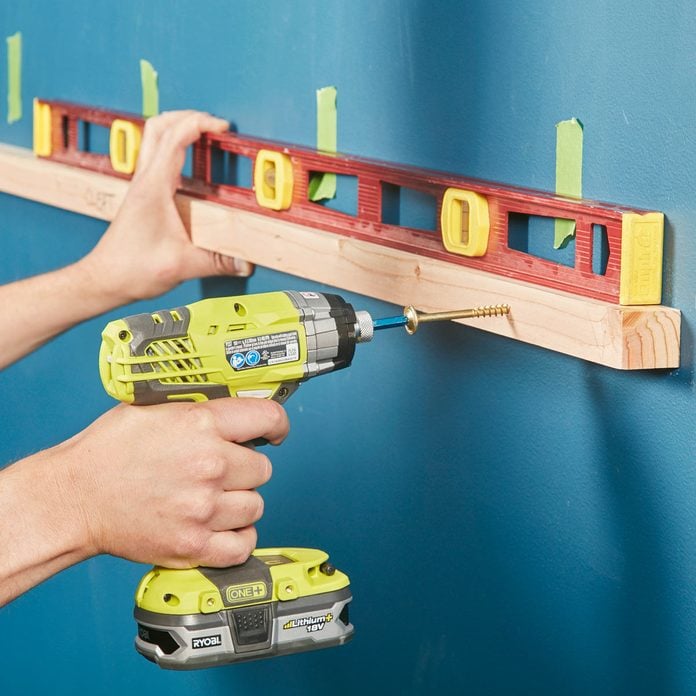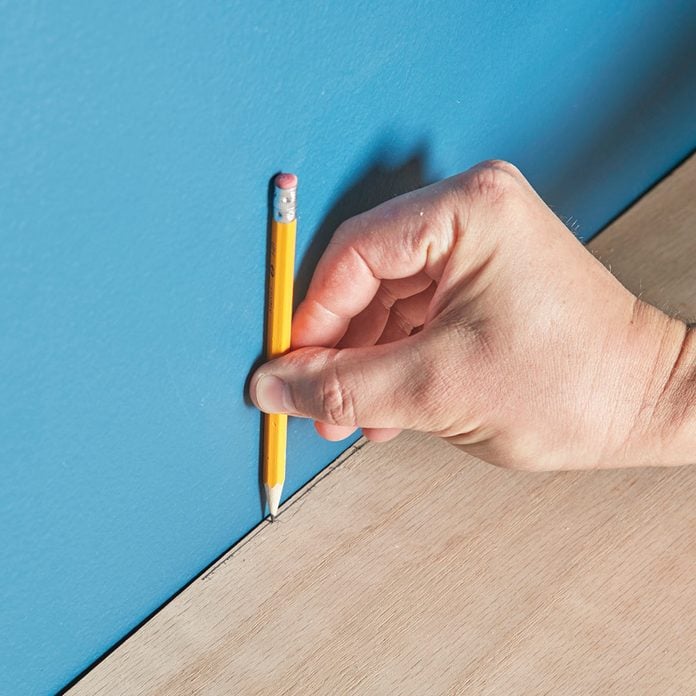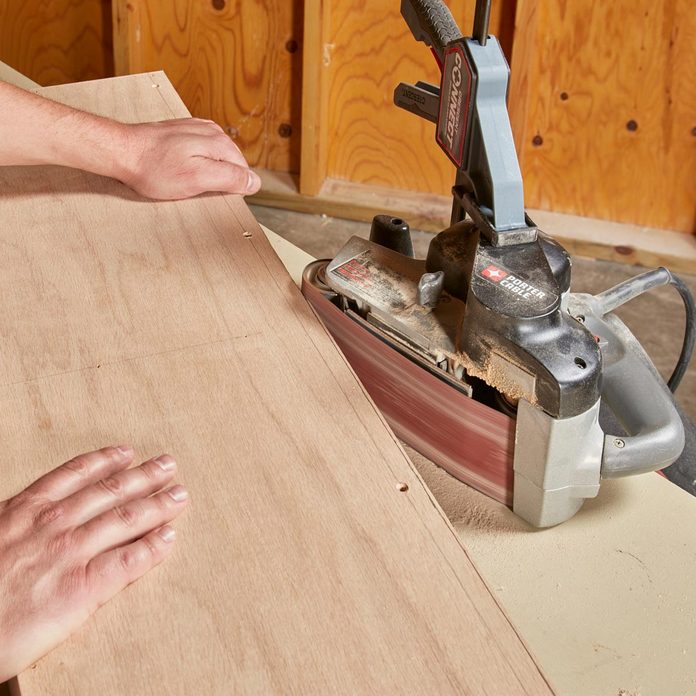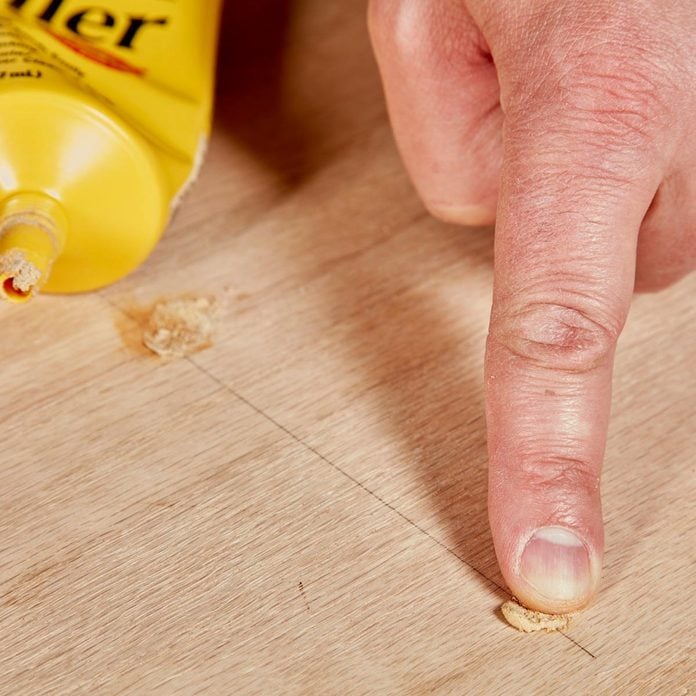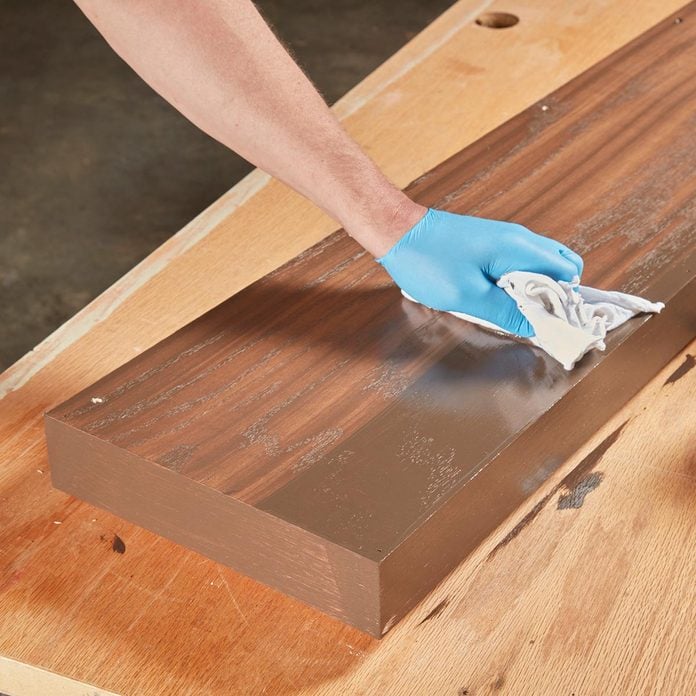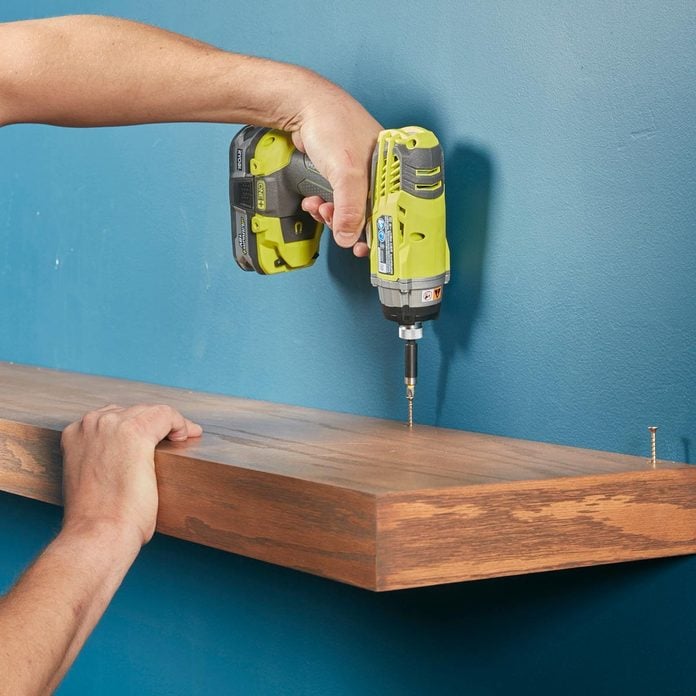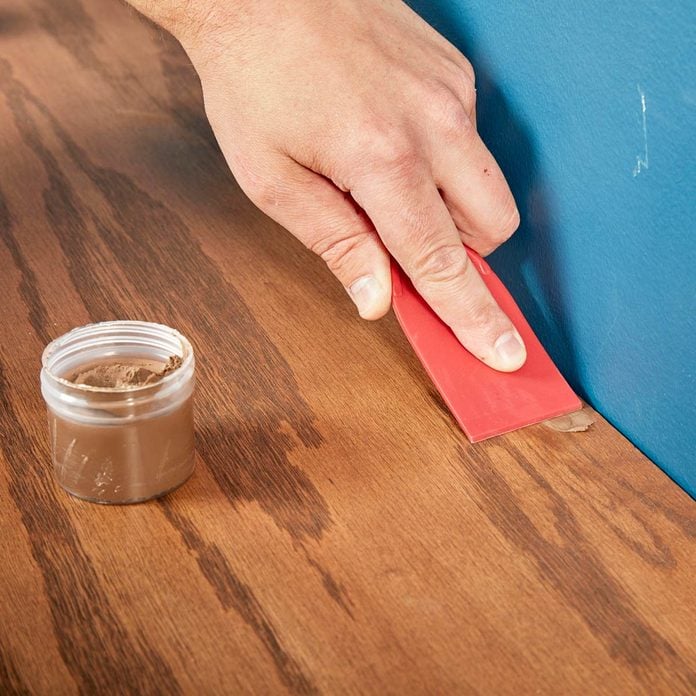How To Build Floating Shelves
Updated: Jun. 02, 2023Customize these amazing floating shelves to suit any room in your house!

- Time
- Complexity
- Cost
- A few hours
- Beginner
- $101–250
Tools
- Circular saw,
- Belt sander (optional)
- Brad nailer
- Edge-band trimmer
- Random orbit sander
- Drill/driver
- Stud finder
- 4-ft. level
Cutting List
Figure A Exploded View
Overall dimensions: 72″ long x 11″ deep (after scribing 1/8″ off the back) x 2-1/2″ thick.
Materials List
- 4’ x 8’ sheet of 1/2” red oak plywood
- 24” x 96” roll of peel-and-stick veneer (enough for seven or eight shelves)
- 2×4 board
- Non-hardening wood putty
- Tack cloths
- 1-5/8” (No. 8) wood screws
- 4″ lag screws
- Stainable wood filler
- Wood stain
- Cotton rags
- Disposable foam paint brushes
- 1” brad nails (18 gauge)
- Carpenter’s glue
Money, time and tools
A pair of shelves cost us about $150 to build. We were able to make two shelves from a single 4 x 8-ft. sheet of 1/2-in.-thick red oak plywood ($40). It can be tough to find locally, so call around before you shop, or choose different plywood.
Our shelves are 2-1/2 in. thick and 72 in. long, so finding veneer long enough on store shelves is also a challenge. You can special-order it at some home centers, however. We bought ours online from Rockler Woodworking and Hardware (rockler.com), where a 24-in. x 96-in. roll costs about $100 shipped. You can find less expensive veneer, but we love this stuff because you don’t have to heat it or apply any glue—it’s just peel and stick! Expect to spend an additional $10 to $20 on stain and other assorted materials.
It took us a couple of hours to build each shelf, including sanding, staining and mounting on the wall. We made ours using a circular saw and cutting guide, but you can make them much faster with a table saw. And you can certainly hand-drive small nails, but it’s much faster and easier to use a pneumatic brad nailer (you can buy one at Harbor Freight Tools for about $20). You’ll need a small compressor to power it. It also helps to have a random orbit sander, especially for sanding the sides flush before applying the veneer. Bonus points if you own a belt sander for scribing!
Self-stick veneer for a solid wood look
A shelf made from a single plank looks great, but long, thick planks can be hard to find, expensive or both. So we cheated and used adhesive-backed veneer made from real wood, which is easy to cut and apply and creates the seamless look of solid timbers. To see how to apply it, check out the photos below.
Build cutting guides for perfect cuts
It’s hard to get nice, straight cuts without something to help guide your circular saw. That’s where a cutting guide comes in. We used a self-squaring crosscut guide for short cuts and a longer guide for “rip” cuts. The guide shown here is just a narrow piece of 3/4-in. plywood attached on top of a wider piece of 1/4-in. plywood, with a squaring fence on the bottom. The base of the saw rides against the guide’s “fence.” Learn how to make a circular saw cutting guide here.
Cut and assemble the parts
Set a full sheet of 1/2-in. plywood on three or four 2x4s laid across sawhorses (photo above). Measure and mark the plywood for each of the shelf parts and use a circular saw and cutting guide to make your cuts. The cutting guide will help keep your cuts perfectly straight and minimize chip-out.
Next, glue and nail all the parts together (photo below). It helps to draw pencil lines on the top and bottom panels first so you’ll know where to drive the nails for the fillers after you cover them with the top and bottom panels. With all eight parts cut to size, it’s fairly easy to assemble the shelf with glue and nails. Start by laying the front rail (C) on end on top of your worktable (an old hollow-core door or plywood scrap on sawhorses works great), plus a couple of short support blocks cut from a 2×4. These blocks will support the top panel (A) while you glue and nail it onto the front rail. Carefully align the top and front pieces and use an 18-gauge pneumatic brad nailer to drive 1-in. brads.
Now stand the side rails (D) on end and glue and nail them to the top panel. Flip the whole thing over and install the fillers (E) with glue and brads. The fillers should be evenly spaced, but don’t be too fussy because they’ll be hidden once you install the bottom panel (B). Nail through the front rail into each of the fillers.
Then flip the whole thing over again and nail through the top panel into each of the fillers. Now flip the whole works over one more time and nail through the bottom panel into the fillers.
Apply the wood veneer
The top and bottom panels have exposed plywood edges that get covered with veneer. If those edges aren’t perfectly smooth and flush with the faces of the front and side rails, the veneer won’t stick properly. Sand everything flush with a random orbit sander and 100-grit sand-paper. Lay out the roll, veneer side down, and draw a straight line using a marker and straightedge at 3 in. wide along the entire length of the roll. This will give you 1/4 in. of overhang when you apply the veneer to the front and sides of the shelf.
Cut along the line with a pair of scissors and then cut the strip of veneer into three pieces for the front and two sides, leaving them long enough so there’s 1/4 in. of overhang on each end. Apply the veneer to the sides first, being careful to keep the veneer aligned with the shelf. Don’t peel and stick more than a few inches at a time, and rub a block of wood over the veneer to press it on. Cutting the pieces slightly oversize helps in case you don’t get it on perfectly straight.
Pull an edge-banding trimmer apart and use one of the two sides to trim the veneer flush with the shelf. This method works well going with the grain of the veneer, but not when trimming across it. For the short cuts across the grain, back the veneer up with a block of wood and trim the veneer flush (on the sticky side) with a sharp utility knife. A handheld router with a flush-trimming bit also works well. Install the front veneer piece after the sides. Then drill several countersink holes in the back of the shelf for some No. 8 wood screws. Space the holes about 12 in. apart and 3/4 in. from the back edge.
Make a wall cleat
Cut a wall cleat (H) out of a straight 2×4 and make it 1-1/2 in. x 1-3/8 in. x 70-3/4 in. Use your circular saw and the same cutting guide you used to cut the plywood pieces to width (set another 2×4 under the guide to keep it from tipping). Rip the cleat to width and then crosscut it to length. The narrow part of the cleat should slip into the hollow opening in the shelf with just a bit of wiggle room.
Using an electronic stud finder and painter’s tape, find and mark the stud locations on the wall. Transfer the stud locations to the wall cleat and predrill holes in the cleat slightly smaller than the diameter of the shanks of the lag screws. Hold the cleat to the wall and drill pilot holes in the wall using the cleat as a drilling guide.
Drive 4-in. lag screws through the cleat and into the wall (Photo 9). Start by driving a lag screw on one end of the cleat, check for level, then screw down the other end before driving the middle screws.
Fit the shelf to the wall
Slip the shelf onto the cleat and tight to the wall. If your wall isn’t perfectly flat, you’ll see some small gaps between the shelf and the wall. You can eliminate those gaps by “scribing” the shelf to fit the contours of the wall, but this step is optional—skip it if you don’t mind the gaps. To scribe, drag a pencil against the wall and trace a line onto the top of the shelf. The line follows the contours of the wall.
Now use a belt sander to sand up to the pencil line. Trying to sand freehand with the belt sander is tricky because if you don’t hold the sander perfectly perpendicular to the shelf, the scribe on the top and bottom panels won’t match and the shelf won’t fit tight to the wall. Instead, turn the belt sander on its side and clamp it on top of a temporary worktable like an old door or scrap of plywood. Turn it on and adjust the belt tracking so that the belt just barely disappears below the surface of the worktable (not all belt sanders let you do this). Run the shelf flat against your worktable and slowly sand up to the pencil line.
Sand, stain and install
Using a fingertip or putty knife, push some “stainable” wood filler into each of the nail holes. The filler might shrink when it dries, so leave a bit extra in each hole–enough that it sits proud of the plywood. Once it dries, sand all sides of the shelf using a random orbit sander and 100- and then 150-grit sandpaper. After sanding with the 100-grit, vacuum or wipe off the sawdust so loose granules don’t scratch up the shelf when you sand with the 150-grit. Vacuum up the dust or wipe it off with a tack cloth and apply stain following the directions on the can. If you want the shelf to look darker, wait a few hours and apply a second coat. Wait a day or two after staining and then brush on three coats of polyurethane for protection.
Holding the shelf over the cleat and tight to the wall, drive 1-5/8-in. wood screws through the pilot holes that you drilled earlier and into the wall cleat. Drive one of the middle screws first to help hold the shelf in place while you drive the others.
With the shelf secured, cover the exposed screw heads with a “non-hardening” type of wood filler colored to match your stain. This type of putty stays soft, allowing you to dig it out should you decide to remove the shelf someday.
Cut the parts
Using a 60-tooth blade in your circular saw and a cutting guide, cut all the parts to size. A 4 x 8-ft. sheet of plywood will yield enough parts for two shelves.
Glue and nail the frame together
Apply carpenter’s glue to the edges of the rails and fillers and nail on the first panel with 1-in. brads. Then flip the shelf over and nail on the other panel.
Sand the front and sides flush
Using a random orbit sander and 100-grit sandpaper, sand the front and sides of the shelf so that the rails and panels are flush with each other. This will give you a flat, smooth surface on which to apply the veneer.
Cut the veneer to size
Using scissors, cut three pieces of oak veneer big enough to cover the front and sides of the shelf. Make them 3 in. wide so you’ll have 1/4 in. of overhang on each side.
Stick on the veneer
Peel off the back and stick on the veneer, leaving a little bit of overhang on all four edges. Press the veneer on firmly with a block of wood.
Trim the veneer flush
Using half of a handheld edge-banding trimmer, trim the veneer flush with the edges of the shelf. You can also use a router with a flush-trimming bit.
Drill holes for screws
Drill countersink pilot holes in the top of the shelf for some No. 8 wood screws. Drill them 3/4 in. from the “wall” edge and space them about 12 in. apart.
Cut the cleat to size
Using a circular saw and a cutting guide, rip a wall cleat out of a 2×4. Make sure the 2×4 you’re cutting from is dead straight.
Screw the cleat to the wall
Drill pilot holes in the cleat and wall and secure the cleat with 4-in. lag screws. There’s no need for fender washers if you use washer-head type screws like the ones shown.
Scribe for a tight fit
Hold the shelf over the cleat and firmly against the wall and drag a pencil along the wall to trace a scribe line onto the shelf. Scribing and sanding (next photo) allow shelves to fit perfectly against wall contours, but you can skip these steps if you don’t mind a few gaps.
Sand to the scribe line
Using a belt sander clamped to a sacrificial worktable, sand up to the scribe line on the shelf.
Fill nail holes
Push “stainable” wood filler into the nail holes, leaving it slightly proud of the plywood in case of shrinkage.
Sand and stain the shelf
Sand all the sides of the shelf using 100- and 150-grit sandpaper. Remove all dust after sanding with the 100-grit to prevent loose granules from scratching the plywood’s surface.
Attach the shelf to the cleat
Hold the shelf against the wall and drive 1-5/8-in. wood screws through the shelf’s pilot holes and into the wall cleat.
Hide the screw heads
Hide the screw heads with wood putty that matches the color of your stain. Use “non-hardening” putty so you can dig it out if you decide to remove the shelf someday. Learn how to build and install DIY floating shelves in your kitchen.
